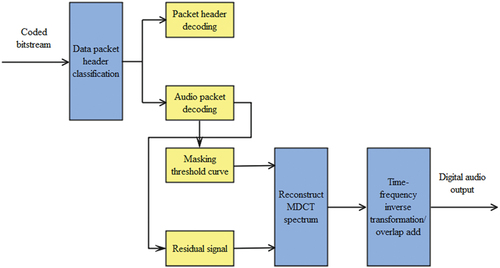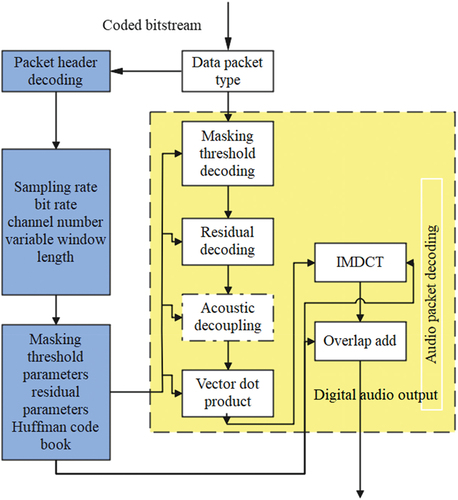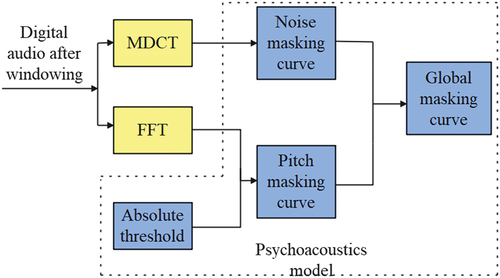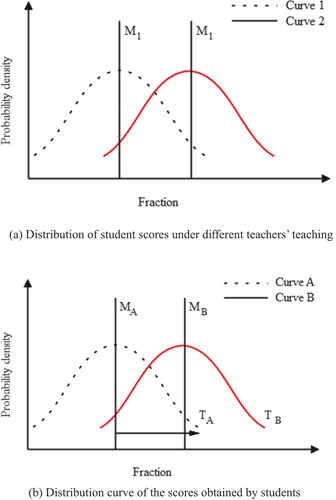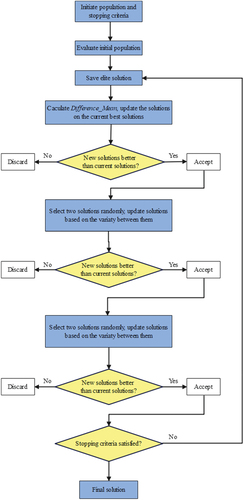 ?Mathematical formulae have been encoded as MathML and are displayed in this HTML version using MathJax in order to improve their display. Uncheck the box to turn MathJax off. This feature requires Javascript. Click on a formula to zoom.
?Mathematical formulae have been encoded as MathML and are displayed in this HTML version using MathJax in order to improve their display. Uncheck the box to turn MathJax off. This feature requires Javascript. Click on a formula to zoom.ABSTRACT
This paper presents a novel approach to enhancing college popular music education by incorporating an elite teaching optimization algorithm into a customized model. A key feature of the proposed model is the utilization of a high-fidelity wideband audio coding algorithm, which employs a time-frequency analysis module based on the MDCT fast algorithm to reduce storage requirements. The psychoacoustic analysis module takes advantage of the high frequency domain resolution of FFT and accounts for differences between MDCT and DFT by calculating masking curves separately. The proposed model is evaluated using the elite teaching optimization algorithm, and results demonstrate that it effectively improves the effectiveness of college popular music education.
Introduction
Elite colleges are generally divided into physical colleges and honor colleges. Among them, the physical colleges set up special classes, are managed by full-time counselors, and set up a special music teaching steering committee, which is responsible for the teacher qualification certification and work assessment of the elite colleges. The elite students of the Honors College are usually scattered in the professional colleges to which they belong, and there is no fixed class and counselor management. The former college is responsible for the daily management, but enjoys the same treatment as graduate students in terms of student management, including borrowing of books and materials, use of laboratories, and scholarship applications. This management model not only reflects the flexibility of the organizational structure, but also conforms to one of the four models of the popularization of higher education summarized by Burton Clark, that is, the elitist reformer. They oppose the arbitrary expansion of traditional expansionists without changing the original system structure of elite higher education, but demand that elite higher education must also be modernized (Wish Citation2020). The elite college not only shoulders the important task of cultivating elite talents, but also carries the mission of innovating the talent training model. The operation mode of elite colleges is different from that of colleges generally established by disciplines and majors, and has formed unique organizational goals, organizational structure, organizational power and organizational advantages (Abeles, Weiss-Tornatore, and Powell Citation2021). From the point of view of the emergence of elite colleges, breaking through the traditional department setting is the first attempt of elite colleges to break the traditional system. As a new type of college under exploration, Elite College has become a pilot for many universities to explore the reform of undergraduate music teaching and develop new education because of its small size of students and rich curriculum content. In addition, due to the special organization and operation of the Elite Academy and the advantageous music teaching resources, it is easier to combine the training of top-notch talents with the reform of undergraduate music teaching. Under the advocacy of the Ministry of Education, programs such as outstanding engineers, outstanding doctors, and outstanding teachers have been launched in various universities for the purpose of cultivating elites. Moreover, many universities’ teaching reform projects aimed at building excellent courses, carried out small-class music teaching, and first implemented them in elite colleges. The establishment of elite colleges enables elite education to be recognized by the system and ensures the rationality of elite education (Kratus Citation2019).
The talent training of elite colleges is a complex systematic project, which involves issues such as resource sharing, responsibility sharing, and system support with the discipline colleges orderly and scientific operation (Vasil, Weiss, and Powell Citation2019). The establishment of elite colleges can create a good academic ecological environment for the construction of “double first-class,” provide high-quality human resources support for the development of disciplines and the possibility of differentiation and integration of disciplines and majors, but the development of elite colleges also faces many problems (Elkoshi Citation2020).
Higher education can be popularized or even popularized, but the ideal of a university is still elitism (Cayari Citation2021). Elite education means that only a few people enjoy the highest quality educational resources. Therefore, talent selection is the key work of elite colleges. For this reason, first-class universities have formulated relatively clear selection standards and strict assessment procedures. However, some elite talents have unique talents, distinctive personalities, and even some quirks, and they are quite different in terms of ability, interest, and mentality. Ren Zuli once pointed out that talents are divided into school-based talents and creative talents. School-based talents are also called exam-oriented talents, that is, students with good test scores. Influential human behavior. There are obvious differences in the needs of the two types of students in terms of learning situations, curriculum settings, and training methods (Gardiner and Kilby Citation2021). In theory, different types of elite traits should be considered when selecting elite students, and all music teaching and curriculum should be based on elite individuals, not groups. On the one hand, elite academies should select elites based on scores, professional rankings or competition results, and on the other hand, they should pay attention to individual interests and mental structure. Therefore, how to select wizards and geeks who may become masters in certain fields in the future, while ensuring the fairness of talent selection, is a difficulty that elite colleges need to focus on when clarifying the selection mechanism (Deákné Kecskés Citation2019).
The currently established undergraduate elite colleges have obvious cross-departmental and cross-faculty characteristics. Courses, majors, teachers and music teaching are basically implemented by relying on various professional departments, and coordinated and promoted by the functional management department of the school. They are generally a special college externally and a management institution internally. The teachers and students of elite colleges are basically distributed in various professional colleges, and most of the leadership teams are attached to other colleges or functional departments (Vasil Citation2020). The establishment and development of elite colleges are more dependent on the leadership of the school, especially the attention of the principal and the support of professional colleges, such as how many excellent teachers are appointed and how many high-quality courses are offered. Therefore, elite colleges lack substantial administrative and academic autonomy, and their development destiny depends on the support of external forces, rather than on the development of the organization itself. The logical premise for the operation of university organizations is academic accumulation. Without the advantages of academic resources, it is difficult to ensure the prominent status of elite organizations. Elite colleges represented by honor colleges often become “shell organizations.” In the process of university academic governance, there must be an imbalance between administrative power and academic power (Li Citation2022).
University courses determine the quality of talent training, but the formulation of curriculum plans for many elite colleges is generally influenced by the rationalism of disciplines, lacking attention to social needs and student participation, resulting in talents that cannot be well adapted to social needs. Literature (Kelly-McHale Citation2018) pointed out that college curriculum design pays less attention to students, and curriculum development lacks clear demand investigation and goal orientation, and is highly arbitrary. Some schools position the cultivation of elite talents as compound talents, but differences and individuality are the characteristics of elites. Therefore, elite educational organizations not only emphasize homogeneity and integration, but also encourage differentiation and individualization when setting courses, and these contradictions are often difficult to take into account in curriculum design and organization. The lack of freedom for students to choose courses also exacerbates the structural contradictions of the courses (Hesselink Citation2021).
Changes in organizational structure, organizational culture, scientific research and academic pressure, etc., to a certain extent, make teachers feel both lack of autonomy and sense of responsibility for the future of elite education, resulting in difficulties or inability to balance their constructed sub-identities. Identify an identity in a field (Schmidt-Jones Citation2018). The organizational development of elite colleges is inseparable from the overall layout at the school level, but also the main responsibility of teachers in elite education (Yaohua and Zutian Citation2021).
The training objectives of elite colleges are often international, compound, and innovative talents, but in the process of “double first-class” construction, the pursuit of individual success of elite students is obviously utilitarian. The growing emphasis on individual academic productivity and success has resulted in a goal-oriented training model, which is in conflict with a process management orientation (Wright et al. Citation2019). The emergence of elites has its own laws, and the large individual differences will inevitably bring about the differentiation and generation of goals in the training process. Compared with the emphasis on elite selection, elite colleges do not pay enough attention to the management of the training process, lack necessary consideration for the process monitoring and effect evaluation of elite training, and ignore the unique learning styles of students. Elites have strong learning motivation and self-consciousness, but the current attention to elite students’ learning cognition is obviously insufficient. Although elite students are generally considered to be highly motivated learners, it is necessary to separate their motivation and abilities (Moir and Stillie Citation2018). The study found that, like their peers, the learning motivation of gifted students varied according to course content, teacher quality and classroom activities, and their perception of the classroom was also influenced by content, interests, and teacher-student relationships. Gifted students pay more attention to the quality of teachers, while ordinary students most often pay attention to the relevance of content (Akuffo and Lamplighter Citation2019). Therefore, teachers are the most important component of the operation of elite colleges, and the positioning of elite talents separated from students and teachers is obviously not suitable for the cultivation of elite talents.
This paper combines the elite teaching optimization algorithm to construct a popular music education model in colleges and universities, to improve the intelligence of popular college music education, and to promote the quality of music teaching in modern colleges and universities. The primary contribution of the paper is the development of a novel approach to improve the effectiveness of college popular music education. Specifically, the paper proposes a customized model that incorporates an elite teaching optimization algorithm and a high-fidelity wideband audio coding algorithm. The time-frequency analysis module of the audio coding algorithm uses the MDCT fast algorithm to reduce storage requirements, and the psychoacoustic analysis module employs FFT and accounts for differences between MDCT and DFT to calculate masking curves. The proposed model is evaluated using the elite teaching optimization algorithm, and the results demonstrate that it effectively improves the effectiveness of college popular music education. Overall, the paper’s primary contribution is the development of an innovative and effective approach to enhance the delivery of college popular music education.
The article is structured in three main parts. The first part discusses two popular music intelligent fidelity algorithms, which are likely to be cutting-edge technologies for music enthusiasts and professionals alike. The second part focuses on the college music education system, which relies on an elite education optimization algorithm. This algorithm is designed to enhance the quality of music education in colleges by optimizing teaching methods and resources. Finally, the article concludes by summarizing the key points discussed in the previous sections and highlighting the importance of integrating these algorithms into the music industry and education system.
Popular Music Intelligent Fidelity Algorithm
New High-Fidelity Audio Decoding Algorithm
The structural block diagram of the new high-fidelity audio decoder is shown in . The decoder judges and classifies the data packets.
The new high-fidelity decoding algorithm is much simpler than its encoding algorithm. Since the algorithm is mainly oriented toward interactive duplex communication applications, codecs appear in pairs. Therefore, the algorithm integrates some functions of its encoder and decoder, such as masking threshold parameters, initialization of residual parameters and generation of HufIhaIl codebook, which are all included in the encoder and decoder.
The new high-fidelity decoding flow chart is shown in .
Since the header packet appears before all audio packets, the decoder must first complete the decoding of the header packet. The decoder completes the necessary initialization according to these parameters, such as initializing some parameters of the masking threshold and residual, and generating the Huffinan codebook. Moreover, the correct decoding of the header packets is a prerequisite for the correct decoding of the audio packets. The new high-fidelity audio packet decoding mainly includes the following steps:
Masking threshold decoding. Since the masking threshold is a segmented polyline approximation to the global masking curve, the amplitude of each segment point is obtained during decoding, and then the obtained segmented polyline (the masking threshold) is interpolated to obtain the global masking curve.
Residual decoding. In order to obtain higher coding gain, the new high-fidelity audio decoding adopts the multi-dimensional Huffman coding method. During encoding, the corresponding codebook is selected according to the dynamic range of the residual, and the number information of the codebook is written into the encoded bit stream.
Channel decoupling. If it is a multi-channel mode, a channel decoupling algorithm is required. After decoupling, each channel’s respective residual signal is obtained.
Vector dot product. Vector dot product refers to the dot product of the global masking curve (vector) obtained by the masking threshold interpolation and the residual signal (vector) of the corresponding channel to obtain the frequency domain parameters of each channel, that is, the reconstructed MDCT spectrum.
Time-frequency inverse transformation. After the frequency domain parameters of each channel are subjected to inverse MDCT transform (IMDCT), a time domain data block reconstructed by the corresponding time domain parameters is obtained.
Stacking and adding. Since the adjacent data blocks overlap by 50% during encoding, in order to reconstruct the current frame during decoding, the reconstructed adjacent data blocks need to be overlapped and added, and finally the output digital audio is obtained.
Key Technologies of New High-Fidelity Wideband Audio Coding Algorithms
A basic process in the audio coding process is to transform the time domain signal into the frequency domain signal. For signals with relatively stable frequencies, in order to obtain the highest coding gain, 1024-point MDCT is used, which can improve the frequency domain resolution. However, when the frequency of the signal changes rapidly, using a 512-point MDCT can improve the time-domain resolution to obtain a time-varying masking domain value.
MDCT is a fully reconstructed linear transformation, but it is not a fully orthogonal transformation. The input time domain signal first passes through a suitable window function and then undergoes MDCT transformation. There will be a 50% overlap between every two adjacent input signals, and they will be connected in sequence. Because the orthogonal change is generally performed in groups, and the coding of each group of coefficients is generally performed independently, the effects of quantization errors on successive groups are also different. In addition, due to the fixed discontinuity at the boundary of the quadrature, there may be a lot of noise at the boundary of these packets, but the human ear is particularly sensitive to this kind of noise. The expression of MDCT is as follows:
Among them,
input signal;
k= spectral coefficient serial number;
N= window function length;
is a fixed time offset;
The equation you provided is a formula for the DCT of a sequence of N real-valued input data samples {x_n}, with the DCT coefficients denoted by {X_k}. The DCT is a widely used transformation in signal processing and data compression, and it is closely related to the Discrete Fourier Transform (DFT).
The equation specifies that the k-th DCT coefficient X_k is obtained by taking a weighted sum of the input samples {x_n}, where the weights are given by the product of the sample values x_n and a cosine function with a specific frequency and phase offset. The cosine function is evaluated at equally spaced points in the interval [0, N-1], with the spacing determined by the frequency parameter k.
The specific phase offset n_0 is a constant term that can be chosen to optimize the DCT computation for certain types of input data. The coefficients h_n are also constants, and they represent the weighting factors for each input sample x_n.
The DCT has a number of useful properties, including the fact that it is an orthogonal transform, which means that it preserves the energy of the input signal. It is also symmetric and real-valued, which makes it well-suited for many types of signal processing applications.
Overall, the equation you provided represents a fundamental tool for analyzing and processing real-valued signals, and it has many important applications in areas such as audio and image compression, speech recognition, and data analysis.
The MDCT spectrum cannot reflect the information of the even part of the first half and the odd part of the second half of the signal. If , then:
This causes time domain aliasing.
The first half is:
The second half is:
This property of MDCT can be used to construct window functions.
Using the properties of MDCT itself, the window function that meets the reconstruction conditions can be limited. We stipulate that MDCT and IMDCT use the same window function, and the process is as follows:
We first perform windowing on the first half:
The second half of the previous frame data is:
After that, the second half of the previous frame of data is windowed:
Overlapping and adding , we get:
The conditions that should be satisfied by the reconstructed signal window function are:
In this way, , and the original signal is reconstructed.
From formula (11), it can be known that:
The window function has symmetry.
However, the computational load of directly calculating MDCT is very large. Considering that the new high-fidelity audio coding algorithm in this paper needs to be processed in real time on DSP, we use the fast recursive algorithm of MDCT to calculate. We assume that the sum we are looking for is as follows:
and satisfies the following recursion relation:
1. Backward recurrence: the value is defined by the following formula:
According to the recursive formula, the sum value f(x) can be rewritten as:
2. Forward recursion: the value is defined by the following formula:
According to the recursive formula, the value f(x) can be rewritten as:
If , the transformation formula of
is written as:
In the formula, N = 2 M is the length of the window, and M is the coefficient of transformation. To get the recursive formula, we set:
We define:
Therefore, we get:
(21)
Comparing with formula (13), we get:
According to the forward recursive formulation of formula (17), we define:
From formula (17), we get:
They are brought into formula (25):
(28)
Formula (28) can be written in the following form
From formula (24), we can also get:
If we bring formula (30) into (29), after mathematical transformation, we get:
Therefore, we can derive from the input sequence x(n) from (24), and at the Nth step, the k-th MDCT coefficient X(k) can be derived from (28) or (31), respectively. It only takes N + 2 multiplications and 2 + 1 additions to calculate the M point output.
Psychoacoustic models are an important part of audio perceptual entropy coding. Because under lossy coding, determining the upper limit of the noise allowed to be introduced is an important issue affecting the coding quality, so the psychoacoustic model plays an extremely important role in coding. In the simplified case, a static model can be used, but since the audio signal is time-varying, a dynamic model is required to track the transformation of the noise masking situation.
MPEG uses two kinds of psychoacoustic models, and its psychoacoustic analysis is based on the FFT transformation of the original audio signal, and the masking threshold is calculated according to the FFT coefficients and corresponding criteria. Although the two psychoacoustic models of the MPEG audio standard have been very elaborate in every detail, they also have shortcomings, such as a large amount of computation. Psychoacoustic models calculate psychoacoustic parameters using a predictive approach to pitch estimation. That is, the required signal-to-noise ratio is calculated using the pitch-predicted FFT-transformed amplitude and phase, thereby determining the masking threshold and a series of signal-to-noise ratios for the signals in each threshold calculation partition. At the same time, the result of the masking threshold comes from the FFT analysis of the original audio signal. Due to certain properties of MDCT, the results of DFT-based psychoacoustic analysis are not always suitable for quantifying MDCT coefficients. In response to this fact, the new high-fidelity wideband audio coding algorithm has been improved accordingly, and a new psychoacoustic model algorithm has been obtained. The psychoacoustic model is shown in :
The new psychoacoustic model not only takes advantage of the high frequency domain resolution of FFT, but also takes into account the difference between MDcT and DFT, and its algorithm principle is as follows:
Calculate the noise masking curve. The method is to obtain the corresponding approximate smooth curve by simple linear regression analysis according to the logarithm value of the output spectral coefficient after MDCT of the signal, and then combine the noise spectrum offset to obtain the final noise masking curve.
Calculate the pitch masking curve. The calculation of the tone masking curve is to calculate the masking curve separately for each spectral coefficient after the FFT of the signal, and combine the absolute threshold to obtain the total tone masking curve.
Calculate the global masking curve. The larger of the noise masking curve and the tone masking curve is taken as the final global masking curve.
The new high-fidelity wideband audio coding algorithm belongs to transform coding, and also faces the problem of pre-echo. Based on the analysis of the pre-echo generation mechanism, a new pre-echo processing method is proposed in this paper.
is a schematic diagram of the audio encoder of the new pre-echo processing scheme proposed in this paper. The original audio signal is input to the pre-echo decision module and the audio preprocessing module. In general, the pre-echo decision module may be designed to detect and classify pre-echo artifacts in the input audio signal. Pre-echo artifacts can occur in audio coding systems due to the use of certain coding techniques and can result in perceptual distortion and reduced audio quality. The pre-echo decision module may use a combination of signal processing techniques, such as time-frequency analysis and psychoacoustic modeling, to detect and classify pre-echo artifacts in the input audio signal.
Figure 4. Schematic diagram of the encoder of the pre-echo processing scheme of the new high-fidelity wideband audio algorithm.
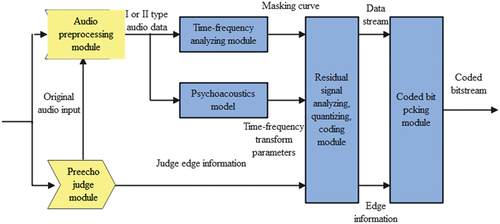
The audio preprocessing module, on the other hand, may be designed to perform various signal processing tasks on the input audio signal before it is fed into the rest of the audio coding system. For example, the audio preprocessing module may perform tasks such as noise reduction, dynamic range compression, or equalization to enhance the quality of the input audio signal. The specific tasks performed by the audio preprocessing module may depend on the specific requirements and goals of the audio coding system.
Overall, the pre-echo decision module and audio preprocessing module are likely designed to improve the audio quality and performance of the audio coding system by detecting and mitigating artifacts and enhancing the input audio signal, respectively.
College Music Education System Relying on Elite Education Optimization Algorithm
To understand the Teaching Learning-Based Optimization (TLBO) algorithm, we assume that there are two different teachers T1 and T2. They teach subjects of the same content in different classes, and students in both classes start at the same level. shows the distribution of student scores in two classes under the teacher’s teaching. Curve 1 and curve 2 are the distribution of scores under the teaching of teachers T1 and T2, respectively, and M1 and M2 are the average of curve 1 and curve 2, respectively. As shown in , the teacher TA tries to move the average score of the class from MA to the new average score MB by teaching the students knowledge. Moreover, the students then need new teachers with more knowledge than they do.
If the distributions are symmetric, it means that the data is evenly distributed around the mean. In this case, the mean and the median will be equal, and the distribution will have a bell-shaped or normal distribution.
If the two classes represented by distributions are both symmetric, it can make it easier to compare the means of the distributions using statistical tests. For example, a t-test assumes that the distributions being compared are approximately normal, and if the distributions are symmetric and bell-shaped, this assumption is likely to hold. This can make it easier to interpret the results of the statistical test and draw conclusions about whether the means of the two distributions are significantly different.
However, it is important to note that even if the distributions are symmetric, there may still be differences in their variances or other aspects of the data that can affect the results of statistical tests. For example, if the two distributions have different variances, this can lead to differences in their spread or variability, even if they have the same mean. In this case, it may be necessary to use statistical tests that take into account both the means and variances of the distributions, such as the Welch’s t-test.
In summary, if the distributions are symmetric, it can make it easier to compare the means of the two classes represented by the distributions using statistical tests, but it is still important to consider other aspects of the data, such as variance, when interpreting the results of the tests.
The flowchart of the Feedback Elitist Teaching-Learning-Based Optimization (FETLBO) algorithm is shown in .
In the elite TLBO algorithm, students only improve their scores through teacher teaching or communication with students, and the learning method is relatively simple. However, in the actual student learning process, students often also actively and purposefully communicate with teachers. Moreover, students can get more knowledge by checking the gaps and filling omissions of the knowledge they have learned through feedback, which can further improve the students’ scores. Therefore, based on the elite TLBO algorithm, this paper introduces a feedback stage to improve the optimization accuracy and stability of the algorithm. On the basis of the above, the effect of the method proposed in this paper is verified, and the application effect of the method proposed in this paper in college music education is verified, and the results shown in are obtained.
Table 1. Analysis of the application effect of the college popular music education method relying on the elite teaching optimization algorithm.
Through the above analysis, it can be seen that the college popular music education method based on the elite teaching optimization algorithm proposed in this paper can effectively improve the effect of college popular music education.
Discussion and Conclusion
First-class universities pay attention to the diversity of teacher sources in the construction process, including scholars from universities, as well as elite talents with rich practical experience, innovative consciousness and willingness to engage in scientific research from government departments, enterprises, and research institutions, so as to realize the sharing of resources. If the teachers of elite colleges are limited to the university, it is not conducive to the development of the innovative vitality and learning motivation of elite students, and it is easy to cause the talents they cultivate to be inconsistent with the needs of society. However, the organizational environment has a positive impact on the professional identity and organizational identity of its members, and temporary and mobile teachers tend to lack a sense of belonging and responsibility. This paper combines the elite teaching optimization algorithm to construct the college popular music education model to improve the intelligence of college popular music education. Through the teaching evaluation, we can see that the college popular music education method based on the elite teaching optimization algorithm proposed in this paper can effectively improve the effect of college popular music education.
The research described in the paper offers several potential advantages in enhancing college popular music education.
First, the use of a high-fidelity wideband audio coding algorithm with a time-frequency analysis module based on the MDCT fast algorithm can reduce storage requirements while maintaining audio quality. This makes it possible to store and transmit audio files more efficiently, which can be particularly useful for online music education.
Second, the psychoacoustic analysis module takes advantage of the high frequency domain resolution of FFT and accounts for differences between MDCT and DFT by calculating masking curves separately. This allows for a more accurate representation of sound perception, which can improve the quality of audio recordings and make them easier for students to learn from.
Third, the proposed model incorporates an elite teaching optimization algorithm, which has the potential to improve the effectiveness of college popular music education. This algorithm can optimize the teaching process by analyzing student data, identifying areas for improvement, and adapting the instruction accordingly.
The advantages of this research include improved audio quality, more efficient storage and transmission of audio files, and the potential for improved learning outcomes through the use of an optimized teaching process.
Some potential pros and cons of the proposed algorithm for enhancing college popular music education can be identified:
Pros:
The use of a high-fidelity wideband audio coding algorithm with a time-frequency analysis module can reduce storage requirements while maintaining audio quality, which can be useful for online music education.
The psychoacoustic analysis module allows for a more accurate representation of sound perception, improving the quality of audio recordings and making them easier for students to learn from.
The incorporation of an elite teaching optimization algorithm has the potential to optimize the teaching process and improve learning outcomes by analyzing student data, identifying areas for improvement, and adapting instruction accordingly.
Cons:
The effectiveness of the algorithm may depend on the quality of input data. If the initial audio recordings are of poor quality or the student data is incomplete or inaccurate, the algorithm may not be able to optimize instruction effectively.
The algorithm may require significant computational resources, which could limit its practical implementation in some contexts.
The paper does not provide details on the cost of implementing the algorithm, which could be a potential barrier to its widespread adoption.
The proposed algorithm has several potential advantages for enhancing college popular music education, but its practical effectiveness and feasibility may depend on factors such as the quality of input data and the availability of computational resources.
The proposed method has the potential to achieve the following improvements:
Improved audio quality: The high-fidelity wideband audio coding algorithm with a time-frequency analysis module based on the MDCT fast algorithm can reduce storage requirements while maintaining audio quality. This can lead to improved audio quality in music recordings, making them more pleasant to listen to and easier for students to learn from.
Improved perception of sound: The psychoacoustic analysis module takes advantage of the high frequency domain resolution of FFT and accounts for differences between MDCT and DFT by calculating masking curves separately. This can result in a more accurate representation of sound perception, which can further improve the quality of audio recordings and make them more effective for music education.
Optimized teaching process: The incorporation of an elite teaching optimization algorithm has the potential to optimize the teaching process by analyzing student data, identifying areas for improvement, and adapting instruction accordingly. This can lead to more effective teaching and learning outcomes for college students.
Overall, the proposed method in the paper has the potential to achieve improvements in audio quality, sound perception, and the effectiveness of the teaching process, which can enhance college popular music education and lead to better learning outcomes for students.
Disclosure statement
No potential conflict of interest was reported by the authors.
Additional information
Funding
References
- Abeles, H., L. Weiss-Tornatore, and B. Powell. 2021. Integrating popular music into urban schools: Assessing the effectiveness of a comprehensive music teacher development program. International Journal of Music Education 39 (2):218–1759. doi:10.1177/0255761420986220.
- Akuffo, G. T. M., and B. Lamplighter. 2019. The music education background of teachers in Ghanaian public primary. Nairobi Journal of Humanities and Social Sciences 3 (4):97–108.
- Cayari, C. 2021. Popular practices for online musicking and performance: Developing creative dispositions for music education and the internet. Journal of Popular Music Education 5 (3):295–312. doi:10.1386/jpme_00018_1.
- Deákné Kecskés, M. 2019. Development of musical taste in public school music education: Do we really need western trends? Képzés és gyakorlat 17 (2019/3–4):137–50. doi:10.17165/TP.2019.3-4.12.
- Elkoshi, R. 2020. Perception of the ternary arch-form in western concert music: Evidence from college music education. Music Education Research 22 (4):388–407. doi:10.1080/14613808.2020.1792866.
- Gardiner, P., and R. Kilby. 2021. Music is music? Striking the balance in music education in wales. Journal of Popular Music Education 5 (1):39–54. doi:10.1386/jpme_00042_1.
- Hesselink, N. 2021. Western popular music, ethnomusicology, and curricular reform: A history and a critique. Popular Music and Society 44 (5):558–78. doi:10.1080/03007766.2021.2000280.
- Kelly-McHale, J. 2018. Equity in music education: Exclusionary practices in music education. Music Educators Journal 104 (3):60–62. doi:10.1177/0027432117744755.
- Kratus, J. 2019. A return to amateurism in music education. Music Educators Journal 106 (1):31–37. doi:10.1177/0027432119856870.
- Li, Y. 2022. THE influence of college music education reform on students’learning cognitive psychology. Psychiatria Danubina 34 (suppl 1):884–86.
- Moir, Z., and B. Stillie. 2018. Haphazard pathways: Students’ Perceptions of their routes to music study in higher education in the United Kingdom. Journal of Popular Music Education 2 (3):199–216. doi:10.1386/jpme.2.3.199_1.
- Schmidt-Jones, C. 2018. Open online resources and visual representations of music: New affordances for music education. Journal of Music, Technology & Education 11 (2):197–211. doi:10.1386/jmte.11.2.197_1.
- Vasil, M. 2020. Using popular music pedagogies to foster 21st-century skills and knowledge. General Music Today 33 (3):46–51. doi:10.1177/1048371320902752.
- Vasil, M., L. Weiss, and B. Powell. 2019. Popular music pedagogies: An approach to teaching 21st-century skills. Journal of Music Teacher Education 28 (3):85–95. doi:10.1177/1057083718814454.
- Wish, D. 2020. Popular music education and American democracy: Why i coined the term ‘modern band’and the road ahead. Journal of Popular Music Education 4 (1):117–25. doi:10.1386/jpme_00017_1.
- Wright, C. L., F. Dillman Carpentier, L. A. Ey, C. Hall, K. M. Hopper, and W. Warburton. 2019. Popular music media literacy: Recommendations for the education curriculum. Policy Insights from the Behavioral and Brain Sciences 6 (2):186–93. doi:10.1177/2372732219858631.
- Yaohua, N., and N. Zutian. 2021. A study on the way of Wuhan S Red music culture integrating into the ideological work of college students. Management Studies 9 (6):504–06. doi:10.17265/2328-2185/2021.06.010.


